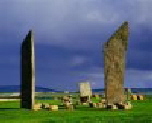|
|
|
|
|
 |
|||||||
|
|
|||||||
|
|
|||||||
|
|
|
Who is an Orcadian ? When the first settlers crossed over to what was to become Orkney around 10,000 years BP, they were family bands of stone tool using hunter gatherers. They probably didn’t know that they were representing the Mesolithic peoples. While organising the extensive collection at the National Museum of Denmark, the 19th-century Danish archaeologist Christian Thomsen proposed an innovative system based on the assumption of a progression in human technology from stone to bronze to iron. Thomsen argued that nobody would have used stone tools if bronze ones had been available and that similarly, no one would have wanted to use bronze tools if there had been iron ones around instead. Reasoning that the advances must therefore have come in chronological sequence, he was the first to suggest a workable system of dating artefacts and sites. Such a system was revolutionary and appeared to be a vast improvement on the disorganised nature of previous prehistoric archaeology. Thomsen's Three Age system was modified into four ages by the subdivision of the Stone Age into the Old Stone (now Paleolithic) and New Stone (Neolithic) ages. Subsequent refinement has added Mesolithic (Middle Stone) and Chalcolithic (Copper and Stone) to the original terms. Use of the full terminology—Paleolithic, Mesolithic, Neolithic, Chalcolithic, Bronze, and Iron—is appropriate only for Europe, the Middle East, and Egypt, and even there it is not uniformly accepted among archaeologists today. The three age system has been difficult to apply fully outside Europe. Cultures developed at different rates or missed out some of the stages of development altogether. Amazonian tribes in South America remain in the Neolithic for example, while there was no Bronze Age south of the Sahara and people living there went straight from using stone to iron. It also soon became apparent that the switches from one age to another did not happen quickly or decisively. Flint tools remained in use in a limited fashion into the Iron Age in Europe and early metal items often appear in what should technically be the Neolithic. Although the three age system has been rendered less and less accurate by archaeological discoveries, it still remains the bedrock of prehistoric archaeology as the terms have become ingrained in people's minds, including those of archaeologists. It is however, like many important 19th century theories, (evolution) an approach that applies a suitably imperial industrial capitalist philosophy to Human development. If you are in the middle of exploiting the peoples of the world or a global scale it is very useful if you can find grand moral justification and inevitability in some supposed process of natural progression. The complexity that defines human development actually suggests that we never left the stone age. In Orkney, up to the 1950’s the primary building material, cleaved sandstone, remained exactly the same as it was 5000 years previously for the builders of Skara Brae. Even the interiors of old style crofts would have been substantially recognisable to the stone builder, with animal byres abutting domestic quarters, roof holes for chimneys and flagstone flooring. Indeed, in the majority of cases the mastery exhibited by the builders of Maeshowe or the exquisite Knap of Howar would have been dismissive of the efforts of 20th century croft builders. Even today, processed or natural stone is by far the greatest single part of all our buildings. A new and more enlightening classification of the past eras of human development might well be overdue. Unquestionably the first division is between stone tool manufacture and metal ore extraction, but consideration should be given to what was lost by this development as well as what was gained. It is a wholly different mind set to fashion tools by hand out of rock as opposed to mining rocks to process by fire into tools. The ancient lithic method simply recycled natural materials. The use of metal ore demanded exploitation of resources on scales that most of us believe only occurred in the industrial age, but in fact as soon as the benefits driven by war and conquest became obvious the sky’s of the ancient world would have been red with fire as millions of acres of woodland were sacrificed to charcoal and ore smelting, and vast open cast ore mines would have despoiled the land. It is not our farmer forefathers who cleared the forests, it was the caste of iron smelters. This technology of mass destruction bore the first major Empires. The need for organisation of these Empires drove the creation of symbolic written communications. The written word, first an accountants tool, eventually broke our connection to our ancestors which for ten’s of thousands of years previously had been maintained through the oral tradition and storytelling. This collective loss of memory has plagued us and brought us to near extinction. Conversely, the written word offers salvation through knowledge or the best use of our advancing understanding of the deep underlying processes of the universe. We remain very much at the wrong end of the counterweight of this catch 22 but optimism and adaptability may see us through. If not, c’est la mort. more to come....
|
|
|
